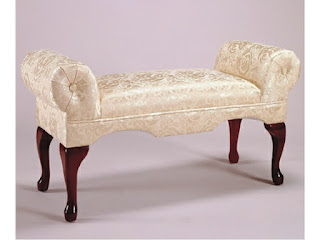From crude basic early chairs of ye
olde England and Scotland, Tudor and Jacobean are notable, often beautifully carved
wood-workings, and later came the more elegant styles of the royal courts of
Louis XVI, and the Georgian/Napoleonic era, thus knowing a common “Settle” from
a “Settee” or “Sofa” takes on new meaning for authors researching these periods
in history.
After all, who really looks at a Settle
and sees it as a basic template for Settee, and where did the sofa derive from?
And yet, all three are merely a glorification of former designs from differing
places.
Jacobean Settle circa 1600s. There were box settles too and ornate carving, some of the settles with drawers, some with cupboard doors beneath the seat, some with lift up lids.
A Georgian Box Settle - note storage space, and it's remarkably plain.
Early 18th Century Settle
During the latter half of the 17th century (English
Restoration) Charles II wished to emulate the glories of the French Court, and regardless
of expenditure, he had the royal apartments within the royal palaces refurnished
and refurbished with plush-padded settees, chairs likewise padded and covered
with tapestry cloth.
17th Century "Settee" - a refinement of a settle - the design lasted throughout Charles II era into the Georgian.
By the dwindling of the Stuart era, Queen Anne, furniture of Queen Anne’s reign became
far less chunky leg-wise and decidedly elegant with a feminine lightness to
structure and lighter fabric coverings, and continued thus into and throughout
the Georgian era.
Queen Anne Chair - likewise Queen Anne Settee followed the same pattern for open-end armrests.
Queen Anne "Sofa" - here we see the high solid sides!
In the short period of the Regency
era, the resurgence for Roman architecture applied to the building of many
houses in the early 18th Century became fashionable and readily
noted at Chatsworth, Blenheim Palace etc. So too, by the mid-Georgian period stone
plinth stools and seats of Roman times became apparent with wooden replicas in
the form of plush settees, chaises, and long footstools.
Here we can see the scrolling aspect and the high sided "sofa".
Chaise Longue
Roller Stool - Roman influence.
Arm Bench - Roman influence.
So where do sofa’s fit into the
equation, one may ask? Then we must look to Eastern Europe and the countries
bordering Asia, to Persia as was (now Iran), to Turkey, and Arab nations, where
high-backed, high-armed sofas were commonplace.
Arab -Asian Sofas
By the mid Victorian era, chunky
furniture once again became in-Vogue, but I’ll not go there for much of it was
ugly and I don’t pen novels in that period of history. At any rate, that’s my
excuse to stop at the end of William IV’s reign.
Look out for next historical aside with Wardrobes and Armoires.













